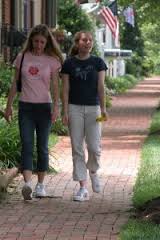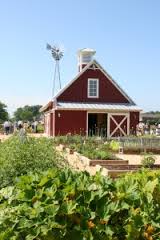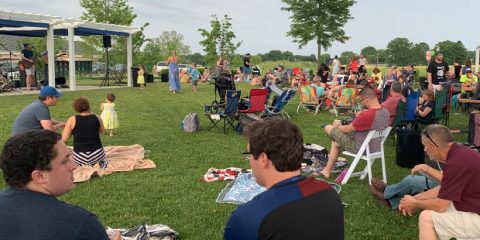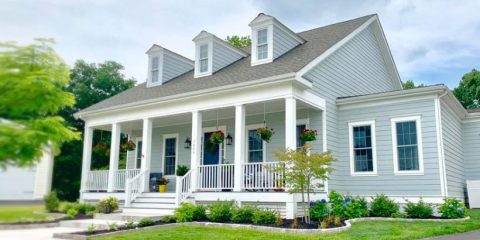Ick! Is Your Neighborhood Diseased? A proposition for a Cure.

One doesn’t have to look hard to see that our health, as a community, is challenged. Take for example these three topics:
Childhood obesity, the Center for Disease Control reports, has doubled in children and tripled in adolescents in the past 30 years. Children and adolescents who are obese are likely to be obese as adults and are therefore more at risk for adult health problems such as heart disease, type 2 diabetes, stroke, several types of cancer, and osteoarthritis. One study showed that children who became obese as early as age 2 were more likely to be obese as adults.
Adult illness, according to senior living expert Ben Brown, could push our medical system to the brink as 40 million baby boomers begin turning 65 by 2020. He cites the AMA as noting, “The statistics are staggering. By age 65, around two-thirds of all seniors have at least one chronic disease and see seven physicians. Twenty percent of those older than 65 have five or more chronic diseases, see 14 physicians — and average 40 doctor visits a year. Situations like these are a nightmare for patients and the physicians who treat them.”
The issue of loneliness, according to blogger Hazel Borys might be as prevalent as the disease depression. She cites PLOS Medicine in their 2010 report, stating, “Loneliness is as dangerous as smoking, and more dangerous than obesity or inactivity. Loneliness also increases blood pressure and sleep disorders. “ Borys continues by quoting, “It isn’t being alone that creates loneliness, but the feeling of being disconnected. According to Jacqueline Olds, author of The Lonely American, we should be putting a greater policy focus on the “potentially devastating consequences of social isolation”
Medical researchers, sociologists and public policy experts are desperately rushing to find the common link. Could perhaps we be seeing a slide in our well being caused by common factors? I’d suggest that those in search of an answer add an architect to their team:
 The impact of walkability: When I was a kid, I took nightly walks with my mom. This subject really hits home with me. But I never knew, other than to be with mom, why I liked to walk. Steve Mouzon, AIA, coined the words (or at least I am believing he did), “pedestrian propulsion”. He likes to study why people walk, how they walk, why they walk farther and why they stop walking. In his book, “The Original Green” he suggests that they won’t walk unless you give them not only a way to walk, but also something to which to walk. Our neighborhoods, at minimum, need sidewalks and slow streets. Couple that with several destinations within the neighborhood and you begin to “propel” the pedestrian. But if you give them nothing but dead ends and no appeal, they are likely to sit on the couch. And where is planning at it’s worst? Have you ever seen a group of seniors loaded into a van, from a greenfield developed senior living center so that they could walk around Wal-Mart? I have!
The impact of walkability: When I was a kid, I took nightly walks with my mom. This subject really hits home with me. But I never knew, other than to be with mom, why I liked to walk. Steve Mouzon, AIA, coined the words (or at least I am believing he did), “pedestrian propulsion”. He likes to study why people walk, how they walk, why they walk farther and why they stop walking. In his book, “The Original Green” he suggests that they won’t walk unless you give them not only a way to walk, but also something to which to walk. Our neighborhoods, at minimum, need sidewalks and slow streets. Couple that with several destinations within the neighborhood and you begin to “propel” the pedestrian. But if you give them nothing but dead ends and no appeal, they are likely to sit on the couch. And where is planning at it’s worst? Have you ever seen a group of seniors loaded into a van, from a greenfield developed senior living center so that they could walk around Wal-Mart? I have!
The impact of connectivity: Connections are important for neighborhoods. At minimum, it improves efficiency. It is easier to get from the house to work or to the ball game, when we have well planned connections and we aren’t stuck with long circular roads that force us to circumnavigate the neighborhood. And they help us walk more. Shorter route with more variety lead to more family walks! But connections are important on a human scale. Well-designed neighborhoods promote socialization and prevent loneliness. For some reason, we have pushed our houses away from the street and moved porches to the back yard. A healthier generation of designs are emerging that return us to the “Main Street” feel of a traditional neighborhood. And designs are getting creative. Consider that in New Town at St. Charles, MO., planners removed mailboxes and centralized the mail facility next to the coffee shop and church. Now, members of the community bump into each other, because it’s planned!
The impact of good architecture: Fr. Roberto Balducelli, from St. Anthony Church speaks fondly of Italian Immigrants and their approach to architecture. He said that, because they came from a place where darn near everything looked like a museum, they had a passion for building beautiful things. Well, I’m not sure what happened, but somewhere along the way, during the era of mass production of homes, our industry lost this passion. But it’s coming back. Some great places compete for great architecture. In Seaside, Florida, residents actually name their houses. Their pride in the beachy architecture is overwhelming. It creates an environment where people enjoy walking and where the pride of residency is obvious.
 Access to fresh food: Are you taking the bell peppers and cucumbers in your market for granted? This might come as a surprise, but it is time that we begin designing and planning urban gardens into our blighted communities. University of Delaware associate, Konrad Kmetz woke me up to the idea that many of our neighborhoods lack fresh produce, he tells me these areas are called food desert. A food desert is a district with little or no access to large grocery stores that offer fresh and affordable foods needed to maintain a healthy diet. Instead of such stores, these districts often contain many fast food restaurants and convenience stores that lack fresh foods. A quick search of the USDA website or a quick tour of some of our blighted neighborhoods proves him right. Konrad is working with a group called the Delaware Urban Farm Coalition that both provides fresh produce to retail shops and convinces them to make room for this important staple on their shelves.
Access to fresh food: Are you taking the bell peppers and cucumbers in your market for granted? This might come as a surprise, but it is time that we begin designing and planning urban gardens into our blighted communities. University of Delaware associate, Konrad Kmetz woke me up to the idea that many of our neighborhoods lack fresh produce, he tells me these areas are called food desert. A food desert is a district with little or no access to large grocery stores that offer fresh and affordable foods needed to maintain a healthy diet. Instead of such stores, these districts often contain many fast food restaurants and convenience stores that lack fresh foods. A quick search of the USDA website or a quick tour of some of our blighted neighborhoods proves him right. Konrad is working with a group called the Delaware Urban Farm Coalition that both provides fresh produce to retail shops and convinces them to make room for this important staple on their shelves.
Delaware has a tradition of great neighborhoods and new ones are emerging. We enjoy the villages of Trolley Square, Dover, Rehoboth and Old New Castle. And we are beginning to see places like Five Points in Lewes, the reemergence of Newark, and the beginnings of the Town of Whitehall address these factors.
Let’s see if we can change the way we live by changing the design of living.

